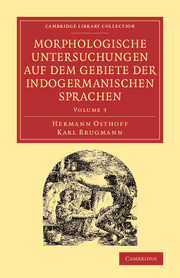
- Publisher:
- Cambridge University Press
- Online publication date:
- October 2014
- Print publication year:
- 2014
- Online ISBN:
- 9781139600125

Hermann Osthoff (1847–1909) and Karl Brugmann (1849–1919) were central figures in the circle of German scholars who rejected a doctrinal approach to the study of linguistics. They came to be known as the Neogrammarian school. At the core of their work was the theory that European languages, together with a subset of languages found in central and southern Asia, have a common origin in a single prehistoric language. They called this ancestor Indo-Germanic (known today as Indo-European) and claimed that its descendants are all related to one another by varying degrees of closeness. This six-volume elaboration of this thesis was published between 1878 and 1910. In Volume 3 (1880), Brugmann explains the rules for conjugation and focuses particularly on how the aorist tense in Greek, Italian and Celtic is formed. He also gives an account of the vowels a, e and o.
 Loading metrics...
Loading metrics...
* Views captured on Cambridge Core between #date#. This data will be updated every 24 hours.
Usage data cannot currently be displayed.